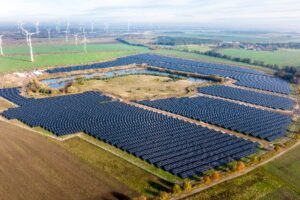Advantages And Disadvantages Of Ethanol

Ethanol is a volatile, colorless and flammable alcohol based on a chemical compound with the formula C2H6O, which is used to improve a fossil fuel or as an alternative to gasoline and diesel.
What is Ethanol?
Ethanol is mainly produced from corn in the U.S., but lately cellulosic ethanol is produced from poplar trees, but also from waste materials such as wheat straw, corn straw, rice straw, sugarcane, wood residues and wood that grows on land which needs to be cleared to be used in agriculture for crops.
Cellulosic ethanol can be produced locally, which creates real opportunities for rural communities.
Ethanol is considered a renewable energy source (clean fuel) that can lower our dependence on the dirty fossil fuels that have already polluted the environment at global scale.
Today, almost all the gasoline sold in the U.S. is blended with ethanol to improve the octane number of the fuel and reduce emissions.
More than 4,000 gas stations in the U.S. are selling today E85, which is a mix of 85% ethanol and 15% gasoline.
E85 is widely used
Everyone that chooses to use E85 will contribute to the reduction of the emissions produced by their vehicle, and this is also the reason why this cleaner fuel has a discounted price.
The other gas stations in the U.S. (a number of over 130,000) are selling different blends of ethanol and gasoline, some of them containing as low as 10% ethanol (E10 is the most common biofuel blend sold in the U.S.).
The main problem created by the production of ethanol in the U.S. is related to the massive consumption of corn, which is also used as a food source.
In order to reduce the consumption of corn for ethanol production, different types of wood and agricultural waste is now used to produce cellulosic ethanol, which has similar properties like the ethanol produced from corn, but is not affecting the production of food in the country.
The production of ethanol for fuel in the U.S. continues to grow, reaching a record of 1,061 barrels per day in February 2017, which shows that the fuel used in our cars will contain more and more ethanol as time passes for better performance and less emissions.
Advantages of Ethanol
Being a clean fuel and also a renewable energy source, ethanol features today more advantages than disadvantages.
1. Is a Fuel that Reduces the Level of Greenhouse Gas Emissions Released by Vehicles
It has been already proved that ethanol is a clean fuel that produces no pollution in the environment.
Cars using a blend of gasoline and ethanol are releasing less emissions that the cars that run only on gasoline, which means that ethanol improves fossil fuels like gasoline by making them more potent and less harmful for the environment.
In terms of spills in nature, a clean fuel like ethanol will never pollute the environment the same way as the products based on petroleum (oil, gasoline, diesel, etc.) are doing.
Ethanol is manufactured from corn or wood waste, and about 75% of the fuel spilled in the environment will be decomposed in less than one week.
2. It Can Be Widely Used By Vehicles With Internal Combustion Engine
Today, more than 90% of the vehicles in the U.S. are approved to use a fuel that contains a small percentage of ethanol (E15 contains 15% ethanol and 85% gasoline).
Using E15 instead of regular gasoline will increase the octane number of the fuel with a small value, but will lower the emissions released by the vehicle with a small, but significant percentage.
If you want to reduce the carbon footprint of your vehicle even more, you need to use a car that is approved and can work with a fuel that contains a higher percentage of ethanol, because the more ethanol you have in your fuel the higher the octane number and less emissions will be released.
3. Ethanol is a Cleaner Fuel than Gasoline and Diesel
Gasoline and diesel fuel are produced from crude oil, which means that they contain hydrocarbons that are released into the atmosphere while we burn these fuels inside the combustion engines of our vehicles.
Ethanol is made of corn or agricultural and wood waste, which means that the energy produced while burning it, is the same energy that was sent by the Sun and was received and stored by the plants (crops and trees) during their life on the planet.
This is the reason why ethanol is cleaner, is made from green plants and trees, not from rotted plants and animals.
The energy released while burning ethanol is green (obtained from alive plants and trees), and is not black like the energy produced by gasoline and diesel fuel (which is made of dead plants and animals).
Mixing ethanol with gasoline (adding green energy to black energy) will generally improve the fuel by making it more powerful and less harmful for the environment.
4. Can Reduce Our Dependence on Fossil Fuels
Introducing ethanol into gasoline to slightly improve the fuel will reduce the emissions in a small percentage, but will also reduce the dependence on the imported fossil fuels.
Cellulosic ethanol can be produced locally (rural communities) from wood and agricultural waste, which will not affect the corn production in the country and will also lower the consumption of fossil fuels (mixing all the gasoline sold in the country with 10% ethanol will reduce the demand for oil).
Using more ethanol in the mix will reduce the dependence on fossil fuels even more.
5. Ethanol Produces A Complete Combustion
In almost all cases, ethanol will produce a complete combustion inside the engine and will produce energy, CO2 and water.
Burning gasoline and diesel fuel will always release carbon dioxide (CO2), and also carbon monoxide (CO), nitrogen oxides (NOx), sulfur dioxide (SO2), particulates and heavy metals like lead, cadmium and mercury, which means that gasoline and diesel are way more harmful for the environment.
A fuel that contains a mix of ethanol and gasoline will ignite faster than gasoline, which will put less strain on the engine and will reduce the fuel consumption (cheaper to run).
Disadvantages of Ethanol
Ethanol is still a fuel (even if it’s not a fossil fuel), which means that there are advantages, but also a few disadvantages with it.
1. Using Higher Ethanol-Gasoline Blends Require Engine Modifications
Using E85 or a fuel that contains a higher percentage of ethanol will require engine modifications.
Actually, using a mix that contains a higher percentage of ethanol than E10 and E15, will require engine modifications.
The modifications are needed due to the fact that ethanol is a corrosive fuel that absorbs water and dirt with ease.
The engine needs to be protected from the dirt absorbed by the fuel (dirt can enter the carburetor, which will affect the engine).
Filters will be used to stop the contaminants from producing damage and corrosion inside the engine block.
2. Has A Lower Heat Combustion
This means that the energy produced from burning one gram of ethanol is lower than the energy produced from burning one gram of high octane gasoline.
The car that uses high octane gasoline will go further than the car that uses the mix of ethanol and gasoline.
Ethanol increases the octane number of the fuel mix, but because it burns at a lower temperature it produces less energy.
3. Ethanol Production Requires Large Areas of Farmland
Today, ethanol is still produced from corn, which means that large areas of farmland will be used to grow the corn and other crops used in the process.
Deforestation is another environmental problem caused by ethanol because the forests are cut to create new farmlands, which will then be used to produce corn for ethanol production.
This way, the farmland is used for fuel production instead of being used for food production, and the forest disappears.
Deforestation will lead to the loss of habitats, which will destroy the environment even more.
4. Producing Ethanol Consumes a Large Amount of Energy
A significant amount of energy will be used to manufacture fertilizers (used by the crops for ethanol production) and in the distillation process (refining ethanol).
Actually, more energy will be consumed to produce ethanol than the energy obtained from its use as fuel.
5. Waste Disposal after the Manufacturing Process of Ethanol
Producing ethanol from corn and other waste materials (agricultural and wood residues), will produce a smelly waste (fermentation liquors) that is hard to dispose without affecting the environment.
Disposing in nature the waste resulted from the ethanol production is always a concern for the environment.
Conclusion
When we talk about a fuel or an energy source there will always be pros and cons, because even if ethanol is considered a renewable energy source it still burns and produces emissions and also requires a large area of farmland for production (which otherwise would be used for food production).
The disadvantages of ethanol are showing that this is not a fuel for the future, the electric cars are much more suited to replace the cars that burn fossil fuels today because the electric vehicles accelerate quicker and produce zero emissions.







